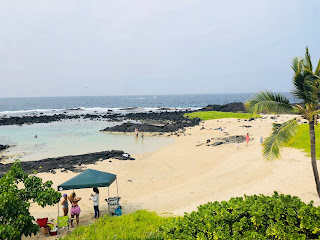Hawaii Volcanologist: 'It's absolutely safe to come to Hawaii Island'
Hawaii Volcanologist: 'It's absolutely safe to come to Hawaii Island'
A senior volcanologist and the Hawaii Tourism Authority emphasize that visitors do not have to change travel plans to the Big Island due to volcanic activity on its remote east side.

With much of the world focused on Kilauea volcano and its new fissures erupting in the Lower East Rift Zone, it may cause concern for travelers coming to Hawaii who are unclear about the state’s geography. To help put your mind at ease, let's first put things in perspective. The outbreaks of lava from Kilauea are limited to the east side of the Big Island of Hawaii in an isolated part of the Puna district called Leilani Estates (a small subdivision totaling roughly 4 square miles located in a lava flow hazard zone)—that’s 20 miles from Hilo and 71.5 miles from Kona.
The lava has not impacted any other areas of the Big Island, nor does it affect the other Islands in the chain. And, not only is distance dividing much of the Big Island from the new lava eruptions, the large land masses of dormant Mauna Kea volcano and active (but not erupting) Mauna Loa volcano stand between Leilani Estates and the other side of the island.
“It’s absolutely safe to come to Hawaii Island,” said Tina Neal, Scientist-In-Charge at USGS Hawaiian Volcano Observatory, at a Hawaii Volcanoes National Park press conference on Saturday. “It could be a very interesting visit because a lot is going on, especially if you’re on this side of the island. Visitors should remain informed and listen to civil defense messages about what areas to avoid.”

speaks at a press conference on Saturday.
Photo: David Croxford
George D. Szigeti, CEO and president of the Hawaii Tourism Authority, echoed this sentiment, “Travelers can enjoy their vacation experience in the Hawaiian Islands to the fullest, with the only word of caution being that they stay out of areas closed to the public for their own safety." Also, know that it’s very difficult to wander into a dangerous area of the Puna district with police and the National Guard keeping watch and manning roadblocks.
With the increase in activity at Kilauea, visitors should also be aware of possible earthquakes and vog (a mixture of water vapor, carbon dioxide and sulfur dioxide) pollution, which are not new to an active volcanic landscape. The earthquakes are largely concentrated around Kilauea and the Puna District, but occasionally can be felt around the island and in other parts of the Hawaiian Island chain, such as when the largest recent earthquake, a 6.9-magnitude, occurred on May 4. Aftershocks are expected, reports USGS, but, in the past two days, the rate of them have significantly decreased and most quakes have since fallen in the 2.0 to 4.0 magnitude range (this can change, of course). Similar to the earthquakes, the closer you are to the volcano the stronger the effects of the vog. How someone may react to the vog varies from person to person, though, based on physical sensitivities, and air quality may be monitored by visiting the Hawaii Volcanoes National Park's air quality website.

Photo: David Croxford
Another thing to remember, eruptions at Kilauea are not new—it’s been erupting continuously since 1983, and has become a popular visitor attraction for that reason. People have flocked to see the red glow of lava at Halemaumau Crater Overlook at the Jaggar Museum; the world watched when lava poured in to the ocean like a running firehose; visitors took popular hiking tours to see the lava flows; and others opted for a helicopter ride around Kilauea’s craters to get a bird’s-eye view of the action from the air. All of these happenings are focused on the same volcano, but what’s new right now is that the lava has moved, cracks have opened in the middle of a residential neighborhood, and it’s unclear where or when it will stabilize. But change is the only thing constant with an active volcano.
Regardless of what’s happening at the remote part of Kilauea on the Big Island’s east side, as long as you stay informed and listen to warnings and advisories, all officials agree there is no reason to cancel your travel plans to Hawaii.

Comments
Post a Comment